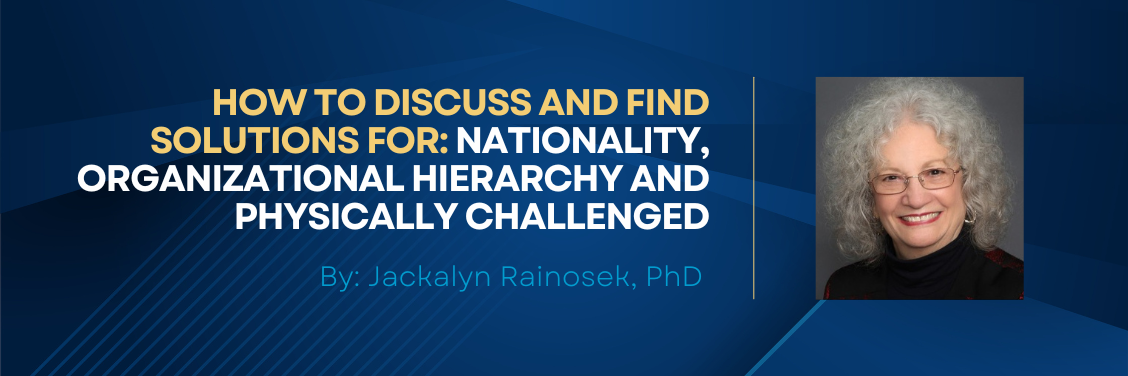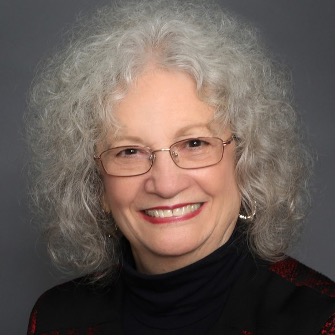How to Discuss and Find Solutions for: Nationality, Organizational Hierarchy and Physically Challenged

Questions to Ask in the Boardroom
- What would be the benefit to the board and the members to have different nationalities on a board?
- How has organizational hierarchy prevented the diversification of boards, and how could a well-designed organizational hierarchy support board diversity?
- Addressing physically challenged people is the new language. What do board members need to know about old and new baselines so they can respectfully invite physically challenged people to be on the board?
Nationality
Organizations and boards are beginning to realize that in order to be competitive in the work market, they must recognize the need to encompass customers of many nationalities with distinct cultural backgrounds. Members of businesses need to speak about, become aware of, and know what is needed to support various nationalities in their work environments. This is also true of board members who have oversight of these organizations.
In the past, the baselines for nationality were limited. Organizations established additional pay for job-enhancing language skills by paying a premium for speaking other languages than English. Their second focus was to hire, train, and retain people from a variety of continents, including on the board of directors. Having more than one nationality was essential to saying the organization was appreciating nationalities and representing the global market. Private and family-owned businesses can have global markets; therefore, their boards similarly need to represent the continents where they have business locations. Depending on the community and organization serves, it is not only organizations that need employees who speak other languages, but also boards need to have members who are fluent in languages that are a part of their organization’s community.
Current day baselines require international organizations to establish a local presence in the countries where they operate by using local personnel. It is important to challenge the organization to truly become multicultural- this focus supports a wide range of religious observances, holidays, dress, and customs, and responds to unique needs with respect to communication style, food, and language. Policies, practices, and competencies have become the new standards necessary for organizations to bring such groups together, whether in one locale or virtually. Boards that have organizations like this need to have board members who are familiar with the events and traditions of their organizational locations.
Some organizations say they are global; yet few truly are. Leading and managing on a global basis means leadership and the board must represent the entire organization and all geographic locations. This creates a corporate culture that speaks to all members of the organization and institutes global management of the organization. Talent searches are global and local talent is developed to run local organizations and bring their voices, perspectives, and leadership to the corporate table. Boards of these organizations must understand and support current baselines of their organization, and members of the board need to have knowledge and experience about the various geographic locations.
Organizational Hierarchy
In the past, the baselines focused on individuals at various levels. The question asked was, “Are all people treated as essential to the organization and shown respect for the talents they have?” The greatest challenge to this happening was the issue of hierarchy. Too often staff and administrative people were treated as one-down or devalued, which did not recognize the inclusion of all people and their contributions to the successes of the organization. Providing career and skill development at all levels began to shift the assessment of a person’s worth from their position to their contribution. The hierarchy of boards has historically been white male; therefore, it is important for you to consider the recommendations about changing how hierarchy is used. If you board has doubt about the benefit of diversity members on boards, I suggest you have your members read this document. The authors have clear statements about the benefit for having a diverse workforce and board membership.
The current guides for success related to organizational hierarchy in a board or organization is an extended-level meeting where each person is a leader, and each is the COO of their job. Staff members need to be recognized as they support teams and boards in their work- talent exists at all levels. Meetings include more than direct reports, since these meetings are open, so the right people are in the room to have the right conversations. The decision-making process involves people at all levels of the organization, and the following questions help determine who needs to be present in meetings: Who is affected by what is decided? Who has the necessary information? Who do we need at this specific meeting? This kind of organization leads to having quality and valuable meetings rather than quantity with limited value. Employees have choices to achieve and obtain promotions whether they prefer to work virtually, in a hybrid approach, or full-time at the business location. In our current climate, boards need to consider how they can get the best people at their meetings, so they have the greatest opportunity to make informed decisions.
Organizational hierarchy becomes a valuable structure, and creates a work environment where diversity, equity, and inclusion are recognized as the foundation for the organization or board. People are able to reach their highest potential and to perform at their highest level of achievement. People reach their highest potential when they are stimulated by diverse points of view and creative thought that comes from diverse membership of boards.
Physically Challenged
Physically challenged people become invisible often to other people. People in wheelchairs are kept isolated from their peers since the work environment does not have adequate pathways to accommodate them. Most organizations have not lived up to the letter or the spirit of the law of the Americans with Disabilities Act (ADA). Many organizations see the cost of ramps and access as too much and either wait until the last minutes to provide them or act only after someone spotlights the issues. There is an assumption that people with physical challenges have something wrong with them. People with less visible challenges often hide them so they will not be ignored or judged as less capable than their physically able peers. This is the one social identity group we will all belong to at some point in our lives, if we live long enough to experience changes in our physical and mental abilities. In the comments below, the ideas presented about the Americans with Disabilities Act and current day language will enhance board discussion about physically challenged members of their board.
The past measures or baselines were adhering to the Americans with Disabilities Act legal requirements and providing necessary accommodations. Boards and organizations supported medical/health benefits that addressed individual’s needs. These actions were a way to acknowledge people with disabilities, and that they had a place in the organization and contributed to its success.
Today, people are not disabled; they have physical challenges. Organizations and boards need to encourage the development of respectful language and interactions with people who are physically challenged. For example, when talking about accommodations use the term “accessible” rather than “disabled” or “handicapped,” and “an accessible bathroom stall” rather than “a handicapped bathroom stall.” Be clear about outdated language and what is respectful language. Organizations and boards have a responsibility to create and environment which promotes the proactive recruitment of and marketing to people with physical challenges. This means including them in “high potential” promotion lists and in advertising images.
It is important to establish support networks and referral services for people with physical challenges, along with their families. If they ask to attend a meeting for the physically challenged or a support group, they need to know their job will not be affected and no judgement of them will occur. They will be respected members of the board. People with physical challenges desire a welcoming place to work where physical barriers are minimized or even non-existent. This says the company values people who are physically challenged and wants them to be a part of the organization. It is also important to enhance support equipment and accommodations. Organizations and boards must accept that off-budget funding for these items announces that the company supports productivity of all employees. Boards will need to collaborate with their executive teams to make certain that new baselines are appropriately prioritized, and action is taken to support physically challenged individuals.
Conclusion
By reading descriptions of nine distinct groups considered in a DEI initiative, the reader will have a better sense of what is required for board members to understand. It is imperative that all of us continue to educate ourselves and experience what it is like for a person to be appreciated for their age, for being an African American, a Black person, a person of color, or a part of the LGBTQ community. We must realize that gender matters and ensure that women have opportunities equal to those of men on boards, which does not exist at this time. White males need to continue enhancing their diversity experiences supporting DEI programs for organizations and their boards. Business must recognize that the physically challenged provide an important perspective as members of any board or organization. Furthermore, global organizations and their boards need to have representation from all localities where the organization has business units. Finally, organizational hierarchy, when structured and employed appropriately, can provide important ways for everyone in an organization to experience the value of a diverse workforce or a diverse board.
More Questions for Board Members to Consider
1. We are members of a board that has a global, not solely regional, presence. How does this organization’s board benefit from members from the local community to be board members?
2. After reading this article and some of the suggested resources, what does the board need to consider about their own organizational hierarchy and also determine whether the hierarchy helps or hinders the expansion and diversity of the board?
3. How can this article help board members to have a greater understanding of the physically challenged and how will this knowledge assist board members to include physically challenged people?

ABOUT JACKALYN RAINOSEK, PHD
Dr. Jackalyn Rainosek is CEO and Co-Founder of DTP Leadership Group, as well as founder and principal of DTP Business Strategies. She has worked extensively with a wide range of Leaders as they make strategic decisions in ever-changing circumstances to achieve extraordinary results and increase profitability. As a senior business consultant and marketing strategist Dr. Rainosek works with business owners and corporate executives to generate optimal results and exponential growth. Dr. Rainosek guides organizations to develop more appropriate leadership styles, enhance cultural competency (through diversity, equity, and inclusion initiatives), and improve levels of trust and cooperation both internally and with the customer base.
Disclaimer: The views and opinions expressed in this blog are solely those of the authors providing them and do not necessarily reflect the views or positions of the Private Directors Association, its members, affiliates, or employees.
